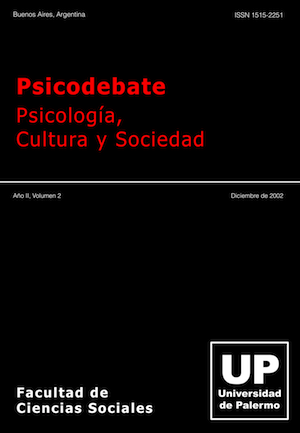Desintegración social y muertes violentas en los países de la Unión Soviética
Resumen
El objetivo del artículo es mostrar que las profundas transformaciones sociales que tuvieron lugar en los países de la Unión Soviética, entre mediados de los 80 y mediados de los 90, provocaron un aumento significativo en la tasa de muertes violentas (suicidios, homicidios y accidentes). Nos apoyamos para ello en una perspectiva teórica de clara matriz durkhemniana, que busca explicar las variaciones en las tasas de muertes violentas a partir de los cambios en la naturaleza e intensidad de los vínculos sociales. El análisis de la evolución de las tasas específicas por regiones, sexo y edad permitió constatar que los grupos más directamente afectados por las transformaciones sociales son los que presentan, también, el mayor crecimiento en la proporción de muertes violentas.
Descargas
Citas
Aganbegyan, A. (1989) Inside Perestroika: The Future of the Soviet Economy. Nueva York: Harper and Row.
Almgren, G; Guest, A; Immerwahr, G. y Spittel, M. (1998) Joblessness, Family Disruption, and Violent Death in Chicago, 1970-1990, Social Forces No 76, 1465-1493.
Baglione, L. y Clark, C. (1997) A Tale of Two Metallurgical Enterprises. Marketization and the Social Contract in Russian Industry. Communist and Post-communist Studies, Vol.30 No2,153-180.
Bonaldi, P. (1998) A 100 años de ‘El Suicidio, confrontaciones en torno a Durkheim. Rev. Sociedad, 12/13, Nov. 98.
Bourbeau, R. y Courville, V: (1997) La mortalité violente selon l’âge, le sexe et la cause: un essai de classification des pays industrialisés, 1985-1989. European Journal of Population, 13, 71-94.
Burawoy, M. y Krotov, P. (1992) The Soviet Transition from Socialism to Capitalism: Worker Control and Economic Bargaining in the Wood Industry. American Sociological Review, 57, 16-38.
Burawoy, M., Krotov, P. y Lytkina, T. (2000) Involution and destitution in capitalist Russia, Ethnography, Vol.1 No1, 67-92.
Carrère D’Encausse, H. (1991) El triunfo de las nacionalidades. El fin del imperio soviético. Madrid: Ed. Rialp.
Castells, M. (1999) La era de la información. Vol. III: Fin de mileno. Madrid:.Alianza. Clarke, S. (ed.). (1995) Conflict and Change in Russian Industrial Enterprise. Edward Elgar, Brookfield, VT.
Connor, W. (1995) Labor in the new Russia: four years on. Problems of Post-Communism, No2 (3) 8-12.
Cook, L. (1993) The Soviet Social Contract and Why it Failed. Cambridge: Harvard University Press.
Cook, L. (1995) Workers in the Russian Federation. Responses to the Post-communist Transition, 1989-1993. Communist and Post-communist Studies, Vol.28 No1, 13-42.
Douglas, J. (1967) The Social Meanings of Suicide. N.J: Princeton University Press. Durkheim, E. ([1897],1990) El suicidio. Puebla: Premia Editora.
Filtzer, D: (1995) Soviet Workers and the Collapse of Perestroika. Nueva York: Cambridge University Press.
Greenberg, M; Carey, G. y Popper, F: (1987) Violent Death, Violent States and American Youth. The Public Interest, No 87, 38-48.
Hixson, W. (1993). Witness to Disintegration. Provincial Life in the Last Year of the USSR. Hannover. NH: University Press of New England.
Holinger, P. (1987) Violent deaths in the United States. New York: Guilford Press. Lane, R. (1979) Violent Death in the City. Suicide, Accident, and Murder in Nineteenth-Century Philadelphia. Massachussetts: Harvard University Press.
Lester, D. (1994) Emile Durkheim, Le Suicide. 100 years later. Philadelphia: The Charles Press Publishers.
Mandel, D. (1995) The Russian working class, privatization and labour- management relations in the fourth year of shock therapy. Labour Focus on Eastern Europe, No 51, 23-55. Martín de la Guardia, R. (1999) Crisis y desintegración: el final de la Unión Soviética. Barcelona: Ariel.
McIntyre, R. (1996) Regional Variations on Russian Chaos: Price Controls, Regional Trade Barriers, and Other Neo-classical Abominations. Communist and Post-communist Studies, Vol.29 No1, 95-102.
Meslé, F., Shkolnikov, V. y Vallin, J. (1994) Brusque montée des morts violentes en Russie. Population, Vol. 49, No 3, 780-790.
Nelson, L. y Kuzes, Y. (1995) Radical Reform in Yeltsin’s Russia: Political Economic, and Social Dimensions. New York: M.E.Sharpe.
OMS, 1995 / 1996. World Health Statistics Annuary.
PNUD. (1999) Transition 1999: Human Development Report for Central and Eastern Europe and the CIS. New York: United Nations Development Program.
Siegelbaum, L. y Suny, R.(eds.). (1994) Making Workers Soviet: Power, Class and Identity. Ithaca, New York: Cornell University Press.
Silverman, B., Vogt, R. y Yanowitch, M. (eds.). (1993) Double Shift: Transforming Work in Postsocialist and Postindustrial Societies. New York: M.E.Sharpe.
Taylor, S. (1982) Durkheim and the Study of Suicide. London. Macmillan.
Weisskopf, T. (1995) Market Socialism in the East. Dissent, No95.
Los autores/as que publiquen en esta revista ceden los derechos de autor y de publicación a Psicodebate y aceptan el registro de su trabajo bajo una licencia de atribución de Creative Commons, que permite a terceros utilizar lo publicado siempre que de el crédito pertinente a los autores y a Psicodebate

















